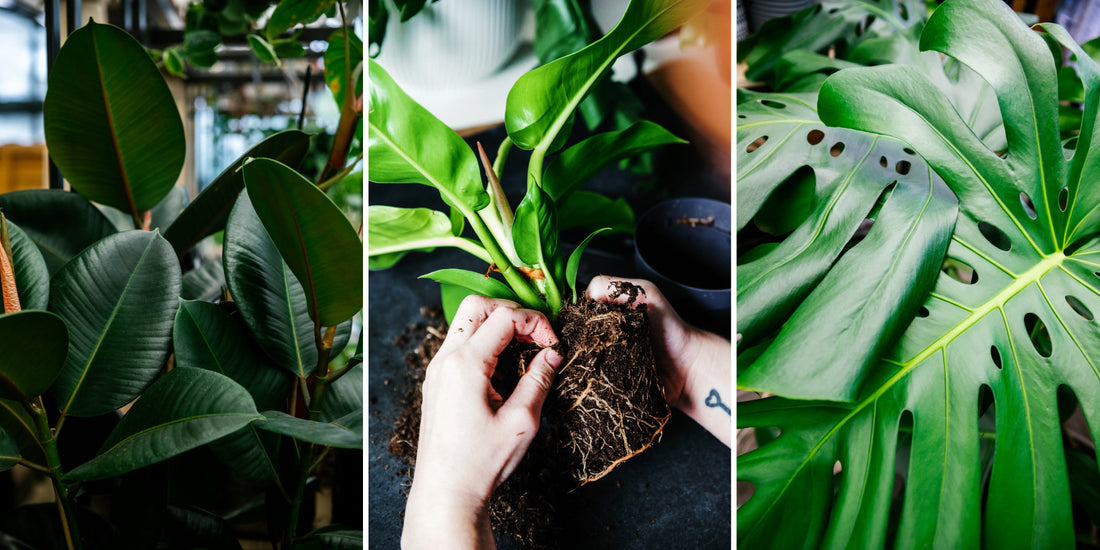There's a lot of conflicting information when researching ‘when to repot houseplants’. And if this is in your search history, you may be familiar with articles that say things like ‘repot every 2 years’ - but what does that even mean? How long has it been in it's pot already? What if there’s roots coming out at the bottom of the pot? Maybe you think it has root rot or an issue with the growing medium? So many questions, right?
Don’t worry, as we are here to delve in and explore the various scenarios and factors surrounding the decision of whether or not to repot your houseplants.
So let's talk about some examples of when to repot.
NEW PLANT
Most of the time when you pick-up a plant from a shop or garden centre, they’ll be potted in Peat Moss (gross). Peat is a cheap and effective way for greenhouses to grow plants, but once you take that plant home, over time it will compact and condense, slowly suffocating your plants root system (which ain’t good).
Many people prefer to repot their plants into a trusted mix when it comes home, which is awesome. However, we recommend that if you do, please allow 2 weeks for the plant to acclimate to your environment. Moving a plant around can be super stressful and then repotting your plant will add even more stress. It's not always clear what your plant has been through already, so just give it time to settle in. This is also a great way to make sure it doesn’t have any pesky little critters hanging about.
If you are concerned about waiting 2 weeks to repot the plant because you think it may have root rot or something else that means it cannot wait; repot and treat as soon as you can. Please allow time for the plant to adjust - you can do this by giving it an ideal spot. Consistency is key.

ROOT BOUND
You may hear that some plants like to be root bound - but take this with a pinch of salt. Allowing your plant to be super root bound can have a negative impact on your plant's health.
Leaving a houseplant root bound for too long is generally not advisable despite the fact that some plants can tolerate it for some time. This practice can lead to several issues, including nutrient depletion as the confined space in the pot exhausts soil nutrients quickly, increased water stress due to reduced water absorption capacity, hindered growth from tangled and compacted roots, decreased stability as the plant becomes top-heavy, heightened susceptibility to pests and diseases, limited flowering and fruiting, and even the potential for the pot to crack under pressure.
So, if your plant has a tonne of roots coming out of the bottom of the pot and the soil seems to have disappeared (as if the roots have started to eat the soil) well it's time for a repot. Which leads me onto the next point...
DETERIORATING SOIL QUALITY
Over time, as the plant grows, the soil in it's current container can become depleted of nutrients and can compact, hindering proper root aeration and water drainage. This tends to happen when the potting medium is Peat Moss. Repotting allows you to refresh the soil, providing the plant with a rich source of nutrients, promoting healthier root development, and ensuring better overall growth. Proper soil quality maintenance through repotting is a simple yet crucial aspect of responsible plant care.

ROOT ROT
If you suspect root rot, there’s no time to waste. Leaving your plant for much longer could mean you have to reroot the plant's whole root system (which could be a lengthy process) or you could lose that plant altogether, if left for too long.
Sometimes root rot is not always obvious – unless you have a clear pot or know the telltale signs.
Signs of overwatering could be;
- Yellowing Leaves
- Wilting and Drooping leaves
- Soft, Mushy Stems
- Growth has slowed down
- Leaves start to drop
If you want to know more about root rot and how to treat it, please check out our root rot blog!
PESTS
Depending on how you treat an outbreak, it may be worth repotting your plant after it's been treated for a bad infestation. If your houseplant is suffering from a persistent pest infestation, such as mealybugs, spider mites, aphids, etc - repotting can put your mind at rest and eliminate any lingering pests or their eggs that might be hidden in the soil.
Please keep in mind that most pests can’t just lay eggs in soil alone. There needs to be a plant in order for any pests to hang out and get busy.
Check out our two part pest blog to find out more on pests and how to treat them - Part One / Part Two
DISEASE CONTROL
The dreaded outbreak of fungal or bacterial infections on your beloved houseplants can happen, unfortunately. Detecting it in houseplants involves observing a range of telltale signs.
Here are a few signs to look for:
Leaves that turn yellow or brown, usually starting at the tips or edges, accompanied by dry and brittle foliage.
Small, dark spots on leaves, stems, or the plant's surface, which may enlarge over time.
Visible mould growth, appearing fuzzy and coloured white, grey, green, or black.
Wilting and drooping, unrelated to watering, can occur as the infection damages the plant's vascular system, leading to slowed growth and stunted development.
Soft or mushy tissues when touched indicate cell breakdown due to the pathogen.
A musty smell may arise in cases of bacterial infection, and dieback of stems or the entire plant can ensue.
Additionally, inspect roots for signs of rot by checking for brown or black discolouration and a mushy texture. If infection is suspected, immediatly isolate the plant and begin pruning off affected parts.
Repotting allows you to remove the contaminated soil and replace it with fresh, disease-free substrate, along with treatment using appropriate fungicides or bactericides as per product guidelines. Following these steps will eliminate the risk of reinfection and provide a healthier environment for your plant.

ADJUSTING YOUR SOIL MIX
Did you just pick up a plant that came in some questionable soil? Maybe it was Peat Moss (can you tell we’re not a fan…) or was it a Succulent in just pure Coco Coir? Plants can turn up in all sorts of substrates depending on where you buy them, swap them etc.
It's better to repot and adjust the soil mix if necessary. Changing the unsuitable soil and potting it into a medium that actually reflects their natural environment, which will give that plant a better chance to thrive.
You may also prefer to use only one form of medium, like hydroponics. So you do you, and repot in the substrate you trust.
Now, let's talk about when NOT to repot!
DORMANCY
During the colder periods, dormant plants are a no go when it comes to repotting - Repotting a houseplant during it's dormancy is generally not advisable for several reasons. Dormancy is a period when the plant's growth slows down, and it conserves energy. During this delicate phase, repotting can cause root stress and disturb the plant's stability. The reduced growth rate also means that the plant may struggle to recover from the shock of transplanting.
During a plant's dormant period, it's crucial to adjust it's care routine to accommodate it's natural resting phase. The frequency of watering should be reduced as the plant's growth slows down or halts; ensure the soil has partially dried out before watering. While some dormant plants may tolerate lower light levels, they still require sufficient indirect light to prevent weakening. Avoid exposing them to extreme cold drafts or heaters.
Allow the plant to go through it's natural rest period undisturbed and refrain from repotting or disturbing the roots. Monitor the plant closely for any changes and adjust the care accordingly. As the dormant period ends and the plant shows signs of new growth, gradually resume regular care with increased watering and appropriate fertilisation to support it's active phase.
Some plants may not go dormant at all, depending on your environment. If your plants show signs of growth, there shouldn’t be any issue to why you can’t repot that plant if you need to.
LARGE AND MATURE PLANTS
Now, when your plants get big and mature to the point it's not something you can easily move around your home - what do you do if you think it needs to be repotted?
Repotting a large, mature houseplant is not always advisable due to several compelling reasons. These well-established plants typically boast extensive root systems that offer stability and support, and disrupting them through repotting can introduce stress and potentially hinder their growth. Furthermore, finding a suitably larger container can be a challenge (we’ve been there) and the sheer size of mature specimens can make the repotting process physically demanding - it could be a 2-3 person job. There's also the risk of overwatering, as larger pots can retain more moisture. If the plant is thriving, disease-free, and not outgrowing its current pot, alternatives like pruning, refreshing the topsoil and proper care can maintain its health without the need for repotting. Repot only when it becomes evident that the plant's well-being or growth is genuinely compromised within its existing pot.

EXTREME WEATHER CONDITIONS
Avoid repotting during periods of extreme weather, whether it's excessively hot or cold. Plants can be more sensitive to changes in their environment during these times, and repotting could lead to shock.
FLOWERING STAGE
If your plant is currently in the midst of producing flowers, it's best to hold off on repotting. Repotting can divert the plant's energy away from blooming and potentially cause the flowers to drop prematurely.
SENSITIVE SPECIES
Some plant species are more sensitive to repotting and changes in their environment. Research your plant's specific needs and behaviours before attempting to repot it, if you are unsure.
-
There are a lot of aspects to think about, but this is a good starting point when working out if you need to repot. Taking into account the plant species, their environment and what you think is best - give it time to acclimate and that plant should thrive and flourish for you.
Wishing you all the growth!

